From Beijing we decided to head to Xiahe and as the train didn’t leave until the early afternoon we decided that I would try to
complete a communist leader tri-fector. Having seen an embalmed Lenin on a school trip and visited Uncle Ho while in Hanoi, it only seemed right to visit Chairman Mao before leaving Beijing. The 60th anniversary celebrations
meant the Mausoleum had been closed for most of our stay. We had tried to visit the previous day, but were thwarted by government officials delaying the re-opening to see their revered leader. As the mausoleum is only open for 4
hours and the queue was at least that long we decided we would try the next day. The following day we arrived early, only it seems that we were not as eager to see the Chairman as his still adoring public, Tiananmen Square
was already packed and they had stopped letting people join the queue half an hour before opening.

Not seeing Mao didn’t stop us completing a tri-fector though as on the train we had managed to book ourselves into bottom bunk
hard sleepers. Bottom bunks are considered the most luxurious as there is enough space between the bunks to be able to sit up and no climbing is
involved. However, it seems that when you have the bottom bunk everybody else sits on your bed too! Maybe it was due to us filling the higher bunks previously that we had not seen this before, but our beds became the seats
for everyone in our cabin. We felt a tinge of guilt for those on the bunks above us though, as one lady on the middle bunks fell onto Jo’s bed when trying to get down from her bunk and then in the morning I was awoken by
the gentlemen from the top bunk accidently standing on my foot. Having completed the hard sleeper tri-fector we both agree that we would choose the top bunk for the privacy and the ability to escape the goings on below.
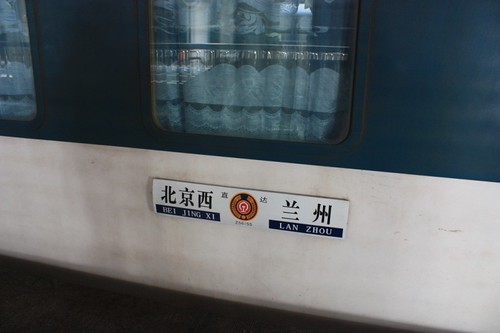
The 17 hour train journey to Lanzhou was only part of the journey to Xiahe as we still had a 4 hour bus journey to get to our final
destination.
Xiahe
Arriving at the bus station in Lanzhou they wouldn’t sell us tickets for the bus until we provided photocopies of our passports
and visas. Not having any we set about finding a photocopying shop, luckily there was one close by. The bus journey went smoothly and we arrived in a decidedly chilly Xiahe, so cold that we went straight for the fleeces and
thermals and even bought some hats.
Our first impression was that it was a huge contrast to the capital, while obviously smaller, the cult of Mao was no where to be
seen.
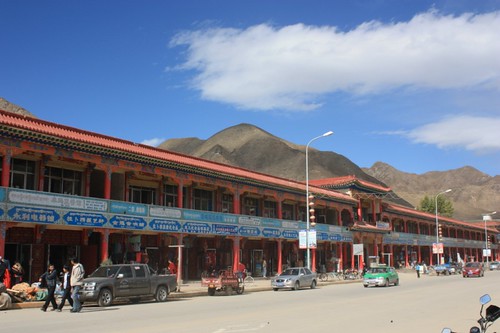
One of the most noticeable things about China is that each new province is like a new country and the people from province to province,
dress distinctly, look different and have differing customs, and Gansu province is no different. Xiahe or Labrang as it is known to the majority Tibetan population, also comprises of Han (Main Chinese) and Hui (Muslim) ethnicities,
as well as Mongolians and Nomads who wander around the streets with huge swords attached to their hips.
The mix of ethnicites doesn’t always mix well, in fact Xiahe has only recently re-opened to tourists. Riots and demonstrations
in the Tibetan capital of Lhasa in March 2008 led to conflict in Xiahe, where 19 people died. Which we assume is why had to provide photocopies to come to the area. Tibet is a controversial subject in China probably more so
than Taiwan (Chinese Taipei), with the Tibetans considering themselves a separate country from China, with China considering Tibet to be part of it’s realm, disallowing the Dalai Lama to visit his adopted homeland forcing
him to live in exile in India.
Despite all this internal conflict the people we met in Xiahe are the friendliest that we have met in China and that is quite something. One of my concerns with visiting China was the language barrier and whether we would be accepted by the locals, but I needn’t have
worried as the Chinese have been some of the friendliest people we have met. Even though most don’t know any English they are always willing to help out and whenever you show the most basic language skills, they will get
excited and talk as if you are a fluent native speaker, to which you have to shrug your shoulders and laugh, to which they laugh back. Of course it has been the children that have been the most fun, as all are intrigued by
us, while some are scared most are cheeky and offer a ‘Nihao’ or 'Hallo'.

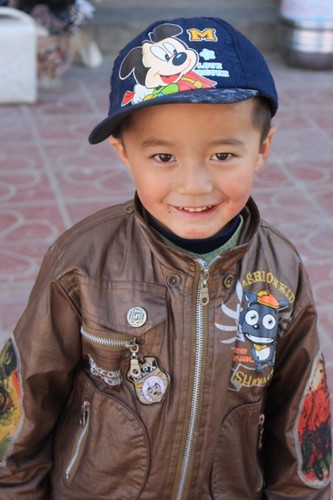
However, the friendly people were not the reason we came to Xiahe, we came to see Labrang the biggest Tibetan monastery outside of
Tibet.
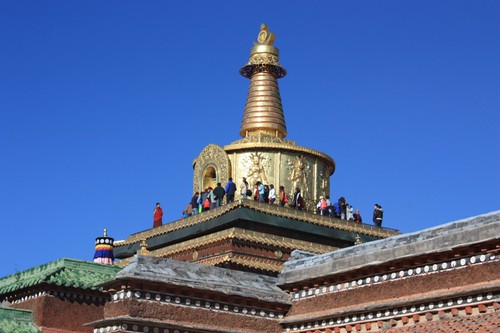
During the cultural revolution between 1966-76, much of the monastery was destroyed and has been rebuilt, the number of monks that
live in Labrang was also reduced from 4000 to 1200 today.
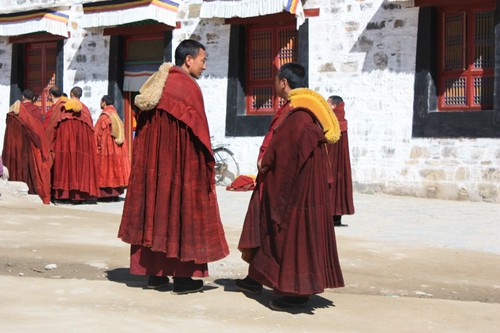
We started our day walking the 3km kora or pilgrimage path around the outside of the monastery walls, adorned with 1174 prayer wheels.

Along the way we saw many pilgrims, spinning the prayer wheels and praying.
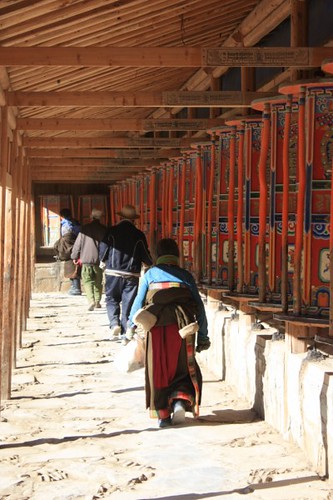
We then took a tour led by a Tibetan novice monk, who spoke perfect English, to see inside of the monastery buildings, where we got
to see the fascinating philosophy school and prayer hall, along with some interesting sculptures made from yak butter. They had a funny smell to them!
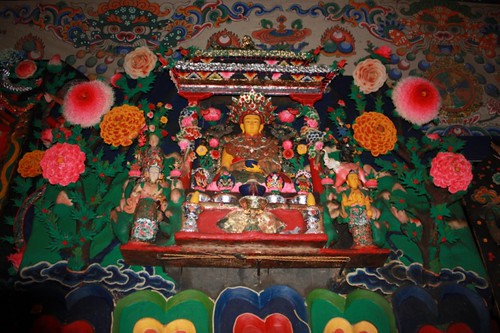
Ganjia Grasslands
Xiahe lies in an area of expansive grasslands so we decided that we would organise a visit to the Ganjia Grasslands, pronounced with
a silent ‘i’. Not many places in the world can you walk around freely asking” Ganja, how much?” But that’s exactly what we did in asking the local taxi drivers how much a trip to the grasslands would cost.
We managed to agree a reasonable price with a driver named Gayou, who didn’t speak any English but was fluent in the language of
laughter and smiles that Chinese have perfected and that we love so much.
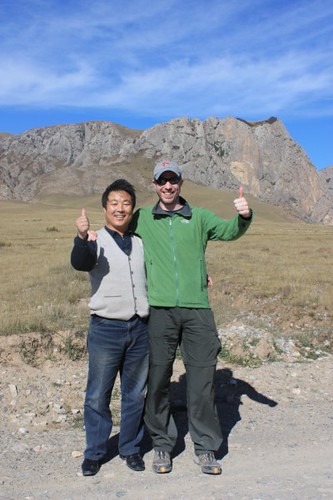
We drove to the grasslands and were met with stunning vistas of the surrounds.
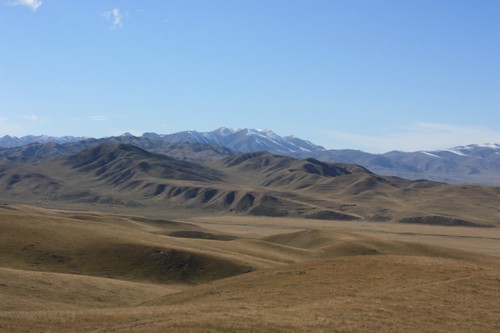
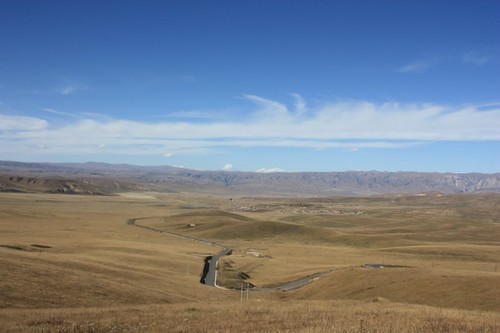
Before visiting Bajiao, a 2000 year old Han dynasty village, protected by a 12 sided mud wall, which we were able to climb to get
a better view of the village.
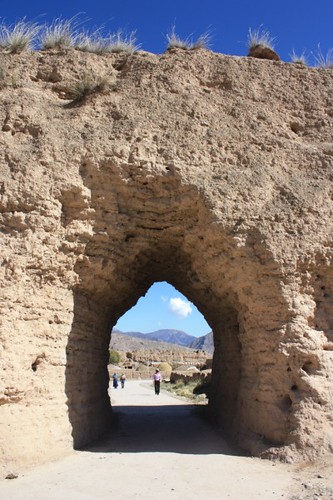
From here we headed to Baishiya to visit the Trakkar Gompa, against a back drop of vertical rock formation.
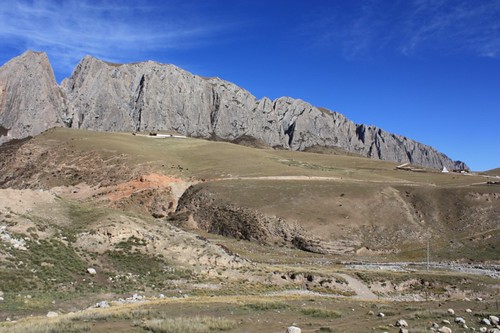
There were many nomads roaming around on their horses, looking like they could have stepped out of a history book.
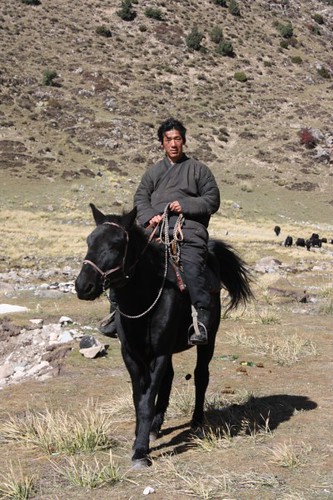
After a long day we decided to have an early night and went to bed, only to be awoken at 10 pm by a
knocking at the door. Opening the door, we were met by a member of the guesthouse staff and two very stern looking policemen, who wanted to see our passports and visas. After presenting them and them checking our details
they didn't arrest us and moved on to the next room. The staff member was very apologetic and said that it was a common occurrence and there was nothing for us to worry about.
Tongren
The next day we caught a bus to Qinghai province and the village of Tongren, which took us through more impressive scenery and a
red rock valley.
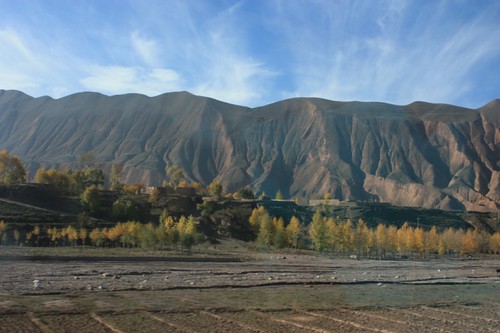
At the first toilet stop of the day, a wall in an small alley, which actually is preferable to the standard public toilet in China.
They usually consist of a trough with a slight gradient, which is full of ‘people waste’ and smells to high heaven and is separated into half cubicles with no doors that you have to squat in, very public indeed! I decided
to get off the bus to stretch my legs while nomads got on to the bus to sell yak yogurt. After a while a white yak appeared in the middle of the road with it’s herdswoman not far behind. The yak looked at me and started
to walk towards me, the herdswoman shouted some command at the beast and it looked back at her and then decided to charge at me, forcing me to run and jump back on the bus. I’m not sure what objection the yak took to me,
whether it was that fact that I hadn’t purchased any yogurt or if I had eaten a relative the evening before.
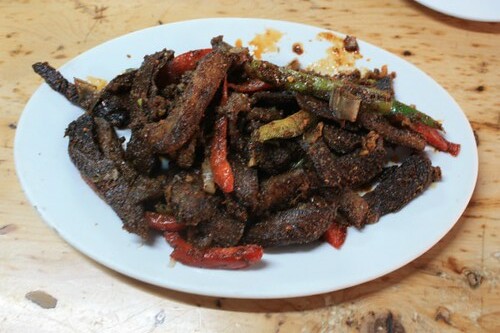
It seems that most people had used the stop to stack up on cigarettes and everyone around us started to chain smoke, filling the
bus with a cloud of thick smoke. In the cities people no longer smoke on public transport but in the rural areas locals still puff away. I now have what only can be described as a smokers cough and I shudder to think about
the poor children on the bus that were subjected to the same smoke cloud. This girl was the daughter of the bus driver so she probably takes the journey all the time.
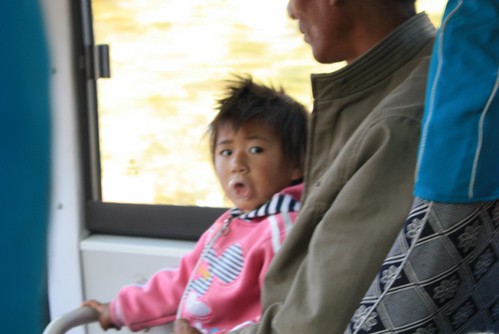
Despite this we arrived in the village Tibetans call Repkong and booked ourselves into the worst accommodation we have had
on the trip. It was one of those rooms that looked a little rough around the edges but ok and then after we had paid seemed to get worse and worse. Nothing worked, everything was falling or fell of the wall during our stay and it
was dirty. The long dark corridor and atmosphere reminded us of the Overlook Hotel in The Shining, we both agreed we would only stay one night not two!
Happy to leave the squaller for a few hours we bartered for taxi to take us to Wutun Si, to visit some monasteries. First we visited
the Mango (Lower) Monastery, which had some impressive temples outside the monastery.
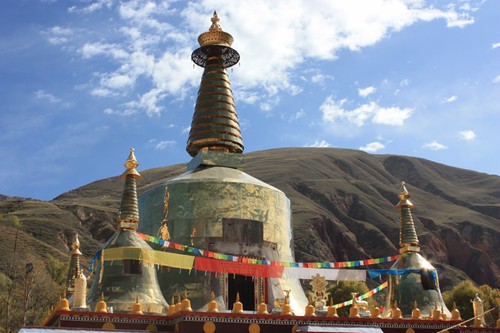
However most of the chapels inside the monastery were closed and we were only able to see the outside.
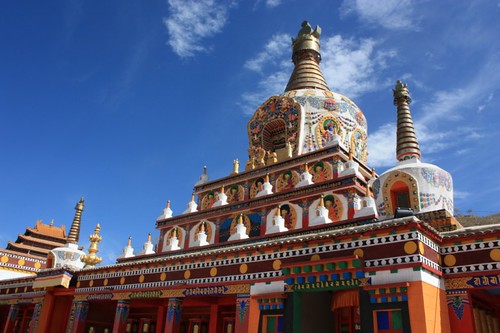
Heading to the Yango (Upper) Monestary we were able able to see the impressive chorten from the outside and were able to go into
the monestary after the monks saw us and said 'money, money, money' to indicate we had to buy tickets.
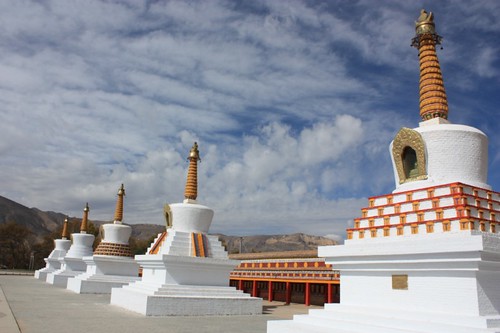
In one of the chapels, we were honoured to be able to watch monks during their school of philosophy and prayer, which is very rare,
seeing them all sat on floor cushions chanting away.
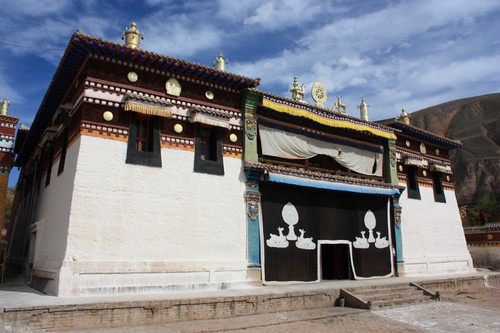
Xining
Having survived our night at the Overlook Hotel, we caught an early bus to Xining and booked ourselves into a nice hostel with a
huge room with a view for our last days in China.
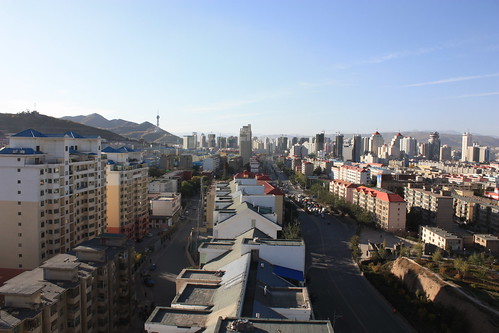
On our first evening at dinner we met a nice Tibetan monk whose English name was Victor and as he left the restaurant he wished us........sweet dreams! How nice. Dinner was like every
other meal we’ve had in China, excellent. Before coming I was worried about the food as I’ve never been a fan of Chinese food. Again I needn’t have worried as the food is some of the best we have had on the trip and
is so much better than the ‘Chinese’ food served outside China and not a mushroom in sight!
The reason for choosing Xining as a place to spend our last days in China is that it is the staring point of the Qinghai - Tibet
railway. Tibet is officially part of China but we’re considering it a separate country despite needing a China visa to visit Tibet, it’s probably best not to get into the politics :)
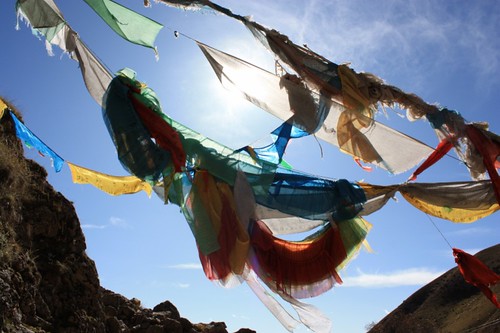
So now we're off to Lhasa.
Ryan & Jo
Photos:http://www.flickr.com/photos/dojo77/collections/72157622494295083/
China Summary
Highlights
Favourite Place - Tiger Leaping Gorge (Jo), Jiuzhaigou (Ryan)
Favourite Attraction - The Awesome Wall of China (Jo), The Great Wall of China (Ryan)
Food - Beijing Duck (Jo), Anything from Sichuan (Ryan), Mapo Dofu (Both)
Beer - Harbin (Jo), TsingTao Stout (Ryan)
Lowlights:
Yangshou (Both)
For those of you thinking of possibly travelling to the region: Costs in USD
Accommodation - Rural $6-15, Cities $12-30
Restaurant meal - $3-5
Food stall meal - $0.50-1
620ml Bottled Beer - $0.75 -1.50
285ml Soft Drink - $1
1.5l Bottle of water - 30c
Bus - $2-3 per hour
Train -$3 per hour